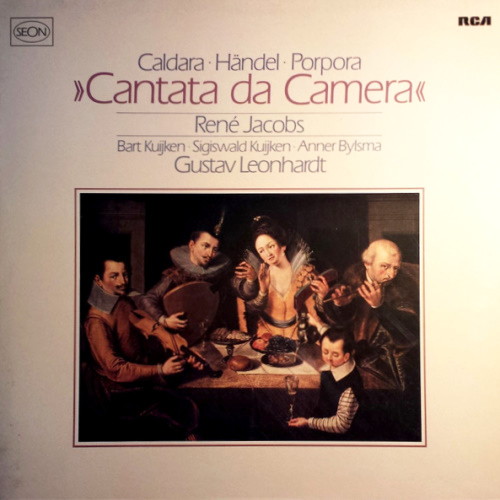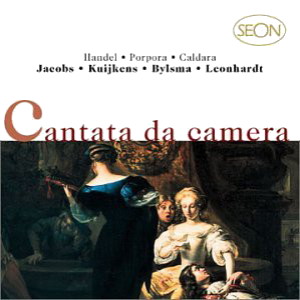 |
1 LP -
6575 058 - (p) 1975
|
 |
| 1 LP -
RL 30417 - (p) 1981 |
 |
| 1 CD -
S2K 63181 - (c) 1997 |
|
"CANTATA DA
CAMERA"
|
|
|
|
|
|
|
|
| Nicola PORPORA (1686-1768) |
Cantata
VIII "Or che una nube ingrata" - for
contralto and basso continuo |
|
15' 59" |
|
|
-
Adagio e recitativo: "Or che una nube
ingrata" |
3' 07" |
|
A1
|
|
- Aria: "Senza il misero" (Lento) |
6' 23" |
|
A2
|
|
-
Recitativo: "M'intendi?"
|
2' 13" |
|
A3 |
|
-
Aria: "Contemplar almen chi s'ama" |
4' 22" |
|
A4 |
| Antonio CALDARA (c.1670-1736) |
Cantata
"Vicino a un rivoletto" - for contralto, violin, cello and
basso continuo |
|
22' 32" |
|
|
-
Recitativo: "Vicino a un rivoletto" |
1' 24" |
|
A5 |
|
-
Aria: "Zeffiretto amorosetto"
(Adagio-Andante) (violino solo) |
9' 27" |
|
A6 |
|
-
Recitativo: "Ma, oh ciel!" |
1' 03" |
|
B1 |
|
-
Aria: "Aimč, sento il mio core"
(Larghetto) (violoncello solo) |
10' 44" |
|
B2 |
| George Frideric
HANDEL
(1685-1759) |
Cantata
"Mi palpita il cor" - for contralto, transverse flute,
and basso continuo |
|
13' 22" |
|
|
-
Recitativo: "Mi palpita il cor" |
2' 04" |
|
B3 |
|
-
Aria: "Ho tanti affanni in petto" |
7' 01" |
|
B4 |
|
-
Recitativo: "Clori, dite mi lagno" |
1' 03" |
|
B5 |
|
-
Aria: "Se un dě m'adora la mia crudele"
(Allegro) |
3' 22" |
|
B6 |
|
|
|
|
|
| René Jacobs,
countertenor |
|
| Sigiswald Kuijken,
baroque violin (Maggini School, Brescia,
mid-17th century) |
|
| Barthold Kuijken,
transverse flute (Gerard Adrian
Rottenburgh, Brussels, mid-18th century) |
|
Anner Byslma,
baroque violoncello (Matteo Goffriller,
Venezia, 1695)
|
|
| Gustav
Leonhardt, harpsichord
(David Rubio, Oxford, 1972 after Pascal
Taskin 1723-93) |
|
|
|
|
|
Luogo
e data di registrazione |
|
Doopsgezinde Kerk,
Amsterdam (Holland) - Novembre
1974
|
|
|
Registrazione:
live / studio
|
|
studio |
|
|
Producer /
Recording Supervisor |
|
Wolf Erichson
|
|
|
Recording
Engineer
|
|
Dieter Thomsen
|
|
|
Prima Edizione LP |
|
Seon (Philips) | 6575
058 | 1 LP - durata 52' 35" | (p)
1975 | ANA
|
|
|
|
|
Seon (RCA Red Seal) |
RL 30417 | 1 LP - durata 52' 35" |
(p) 1981 | ANA |
|
|
Edizione CD |
|
Sony | SBK 63181 | 1
CD - durata 52' 35" | (c) 1997 |
ADD
|
|
|
Original Cover
|
|
Jan Weenix
(1642-1719), Galante
Gesellschaft im Freien
(c.1667) Leipzig, Museum der
Bildenden Künste.
|
|
|
Note |
|
-
|
|
|
|
|
The Italian
solo secular cantata came
into being around 1600 with
the birth of monody, the new
accompanied solo song. After
1650 it was cultivated
primarily by the Neapolitan
school headed by Alessandro
Scarlatti. Scarlatti wrote
about 600 solo cantatas, in
which he experimented with
every possible type of form
and means of expression,
including extremely
sophisticated forms of vocal
ornamentation. During the
first half of the 18th
century the tradition was
carried on by both Italian
and by Italian-influenced
German composers. The solo
cantata was thought of at
this time not only as a
musical form but also as a
poetic one. As a rule the
first aria, often a slow
one, served to present a
description of the
situation, for instance in
the form of a lover’s
lament; the second aria, a
quick one, aimed at
resolving the conflict. The
arias were nearly always in
‘da capo’ form and preceded
by secco recitatives or
ariosos. This sequence of
recitative and aria is taken
straight from Neapolitan
opera seria, in fact the
only difference between the
opera and the cantata was
that the latter was
performed without scenery or
action and in a “chamber”,
i. e. performed privately in
the homes of the middle and
upper classes, at
“academies” (musical
societies) or in the courts
of princes.
The Neo-Neapolitan Nicola
Porpora (1686-1768) was
equally successful as a
composer of operas and of
cantatas. In 1733 the rival
faction in Handel’s London
called in his services,
admiring in his works their
technical perfection, their
nobility of expression,
melodic elegance and
emotional sensitivity. In
the long run Porpora fared
no better in London,
however, than Handel had
done with his operas. “Or
che una nube ingrata” is one
of 12 solo cantatas
published in London in 1735.
The cantata follows the
customary pattern in its
choise of text and formal
scheme. In the introductory
arioso the mood of deep
despair is masterfully
depicted, the emotional
intensity finally reaching a
climax in the following G
minor aria. The second aria
is relaxed and cheerful.
Vocal ornamentation is used
only sparsely throughout.
One noticeable feature of
this cantata is the
carefully and smootly worked
bass part - possibly
inspired by Handel - which
presents a beautifully
balanced counterpoint to the
vocal line.
The text of the cantata
"Vicino a un rivoletto" by
the highly gifted Italian
composer antonio caldara
(c.1670-1736) leads to no
dinal dénouement. The text
relates how Prince Coriolan,
pining for his Cleopatra,
urgently beseeches the
gentle zephyr to carry a
message of love to her. But
neither the zephyr nor the
rest of Nature heeds his
misery. Caldara sets the
text with great contrapuntal
skill. Being employed as
vice-imperial court
capellmeister in Vienna
under J. J. Fux,
however, he naturally
orientates himself according
to traditional northern
styles. All three parts -
that of the voice, of the
continuo bass and of the
solo violin/solo violoncello
- are woven into a
polyphonic whole,
particularly the two solo
parts, which frequently play
in duet, spinning the melody
between them, the one taking
over from the other. The
virtuoso violin part
introduces additional
touches of sound-painting,
e. g. the portrayal of the
wind in the first aria,
whereas the cello heightens
the atmosphere of melancholy
and mourning in the final
section. Although the piece
uses little in the way of
coloratura ornamentation, it
is vocally very demanding,
particularly in the
Larghetto, a moving lament
of the forsaken lover. From
the point of view of form
the composer takes several
liberties. He adopts the
obligatory ‘da capo’ form
for his first aria, but
introduces a gradual
building~up process: after
an initial “adagio” bar, in
Which the violin plays in
almost extemporizing manner,
the aria sets off “andante”,
later changing to a
sprightly 3/8-time
“allegro”.
George Frederic Handel
(1685-1759) became
acquainted with the solo
cantata form at first hand
while on his visit to Italy
in 1707. His meeting with
Alessandro Scarlatti, at the
“Arcadia Academy”
of the Roman Cardinal
Ottobuoni, proved to have a
lasting effect on the young
composer. Without intensive
study of the Italians’ art
of writing melody and of
dramatically constructing
short scenes Handel would
probably never have become
the great opera and oratorio
composer that he later was.
Inspired by Scarlatti Handel
immediately set to work and
produced 72 solo cantatas of
his own, among them “Mi
palpita il cor”. The theme
is again one of passion,
love, despair and anguish.
The opening recitative is
already charged with
dramatic fire: after only
nine bars of arioso, at
“agitata č l’alma mia”,
Handel inserts an aria-like
section with brilliant
colorature before closing
with a simple secco
recitative. The following
siciliano aria in E minor
with its gently rocking
rhythm and flute
accompaniment creates a
lyrical point of rest. In
smooth cantabile style, with
much imitative work, voice
and flute complement each
other in duet. In the
connecting secco recitative
tension mounts again. The
dramatic climax is then
reached in the final
coloratura Allegro aria. An
extremely effective work
full of rapid changes of
mood, this cantata is
evidence that Handel at the
age of twenty-two was
already a music-dramatist
par excellence.
Lothar
Hoffmann-Erbrecht
English
translation by Avril
Watts
|
  |
|
|